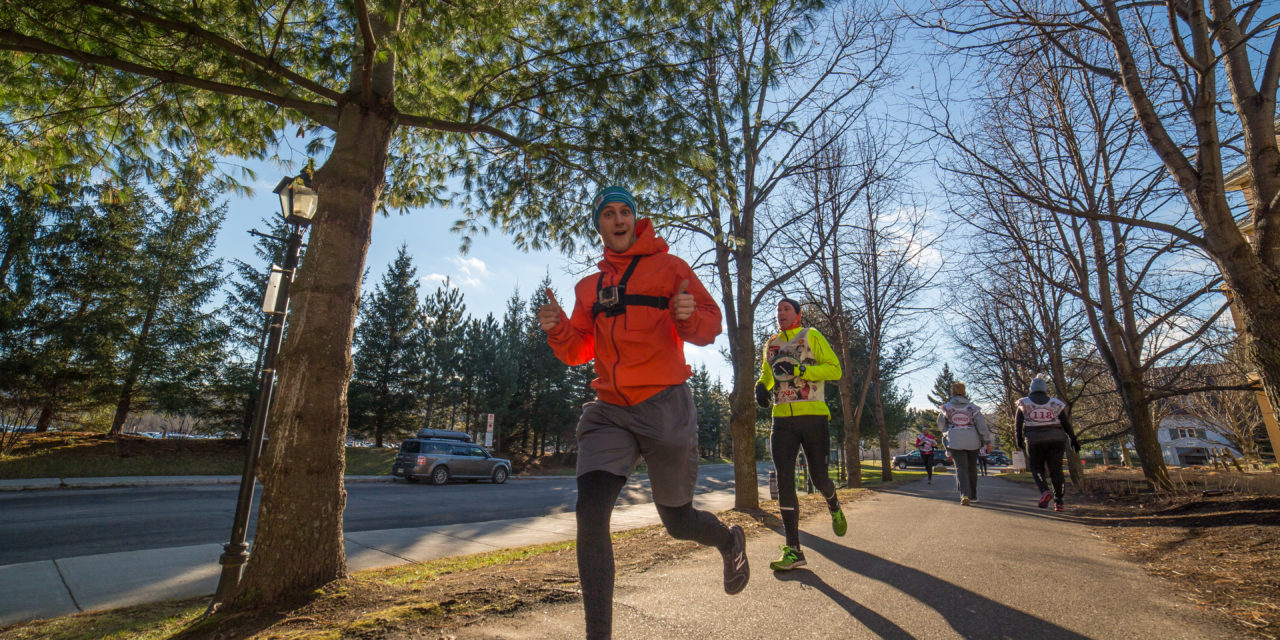Tremblant’s 24h is a 24-hour relay challenge to raise funds for children’s causes. It’s a noble endeavour that puts the focus on physical exertion; what a great combination!
It takes time and energy to prepare for a physical challenge of this kind. Ask anyone who does an endurance sport and most will say the same thing: along with the physical preparation required for a given effort, other factors, such as environmental conditions, must be taken into consideration.
It’s easy to forget, but cold, heat, rain, wind and the running or walking surface play an important part in the practice of an outdoor sport.
The cold has physiological effects. In other words, it can impact your performance. To better prepare your body and metabolism for the frigid temperature and physical effort of Tremblant’s 24h, here are a few useful tips you’ll fully appreciate during your experience.
Sweating
Yes, you will sweat! It doesn’t matter if the external temperature is hot or cold; perspiration will occur in proportion to physical intensity and other internal bodily factors. How you maintain internal equilibrium, or homeostasis, is another story.
Priority #1: proper clothing
The right clothing is crucial in insulating the body against winter temperatures. Eschew traditional sportswear if you want to be sure of a safe and pleasant outdoor experience. Winter garments increase body heat significantly and also promote perspiration when the body is exerting itself. You’ve surely felt it before – that thin film of sweat on the skin during exertion, even during a winter activity! When you cease or slow an outdoor exercise, that sweat will make your body temperature plunge and, in so doing, increase the risk of hypothermia. For that reason, the quality of the garments you choose is important – merino wool or breathable synthetic fabrics should be favoured.
Use the onionskin technique!
Apart from fabric quality, layers are important in promoting the evacuation of heat while maintaining an optimal body temperature. First, the garment directly against the skin must wick away moisture, so the best bet is a synthetic fabric or merino wool. Avoid cotton at all costs! The second layer provides warmth; ideally, it is a warm and breathable fabric, such as wool, light goose down or polar fleece. Lastly, a windproof, waterproof jacket is the outermost layer that will offer protection against the elements.
Good to know: the link between body temperature and hydration
A drop in skin temperature will decrease the perception of thirst; this means you will hardly notice that you’re becoming dehydrated. You can easily lay the groundwork for proper hydration by drinking plenty of fluids in the days leading up to the challenge and, of course, during it. An indicator of correct fluid intake is when your urine is clear in colour and abundant.
Eating well
Food, regardless of form, quantity and in what order you eat it, is always a critical aspect of athletic performance.
Tip: the importance of carbs
Put carb-rich foods at the top of your list. Why?
Nutrients are the energy source that will keep you going during the 24h. Contrary to popular belief, cold temperatures do not beget a need for more fats as fuel. In fact, studies have used biomarkers to clearly demonstrate that the body actually has a harder time using free fatty acids (FFAs) for energy during physical exertion in cold temperatures. The issue stems from inadequate hormonal stimulus: the body prefers glycolysis — the metabolic process that breaks down of glucose (sugars) and glycogen (starch) for energy. It is the easy and fastest way for the body to make energy.
Better thermoregulation restores equilibrium to the metabolism while you practice a physical endurance event. Caloric intake should be heavily oriented toward carbohydrates, preferably consumed before and during the challenge to promote glycolysis.
The temperature of your beverage makes a difference
Not too hot, not too cold: the water or energy drink you ingest during the event should be a moderate temperature. That way, the body doesn’t expend energy regulating the temperature of the liquids.
Beware the energy deficiency!
Insufficient fuel can lead to an energy deficiency and put the body at risk of hypoglycemia (a drop in blood sugar levels) more quickly and severely than it would in temperate environmental conditions. It’s a fact: the body will burn more energy when subjected to a colder temperature.
To conclude: thermoregulation (maintaining a constant internal body temperature) is key to exertion in cold weather. So pay close attention to each factor that might influence a change in your body temperature, whether it be clothing or fuel!
Enjoy your 24h!
Le Kinésiologue





